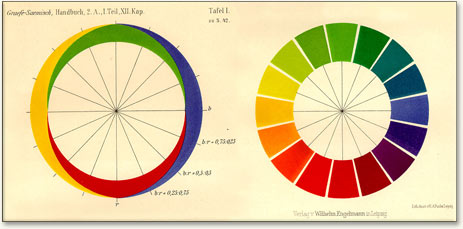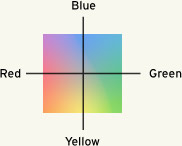What is Color?
Similarly, when we look at a scene, our visual nerves register color in terms of the attributes of color: the amount of green-or-red; the amount of blue-or-yellow; and the brightness. To see how colors are registered in terms of the attributes of color, point at the painting by Renoir below.
Note that these attributes are opposites, like hot and cold. Color nerves sense green or red — but never both; and blue or yellow — but never both. Thus, we never see bluish-yellows or reddish-greens. The opposition of these colors forms the basis of color vision.

Ewald Hering (1834-1918) devised the first accurate theory of color vision. He theorized the “opponent” nature of green/red and blue/yellow. Hering expanded on the ideas of Goethe and Schoepenauer.
Color attributes were first understood by 19th century physiologist Ewald Hering, who made the color charts below. His charts show how all colors arise from a combination of green-or-red, blue-or-yellow and brightness. (In his diagram, the green-neutral-red is vertical, and blue-neutral-yellow is horizontal.) The left circle shows relative mixtures of color attributes. The right circle shows what we perceive when these attributes are mixed.

We can understand much about color by considering how the green-red and blue-yellow color attributes interact. For example, contrasting colors are diametrically opposite on the color circle.

A modern representation of color space. This is conceptually similar to Hering’s circles, but the middle fades to gray.
The artistic term “hue” is the edges of the square (the outside of Hering’s circle); “saturation” represents where the color is placed between grey middle and the colored edge; “value,” also called “brightness” or “luminance,” is the intensity of the color and is the third attribute.